Development of TiO2/ZrO2 Multi-Material Obtained from Ceramic Pastes for Material Extrusion
Abstract
:1. Introduction
2. Materials and Methods
2.1. Starting Materials and Paste Preparation
2.2. MEX 3D-Printer
2.3. Multi-Ceramic Samples and Post-Treatment
2.4. Characterizations
3. Results and Discussion
3.1. The Linear Shrinkage Study and the Characterization of Multi-Ceramic Samples after Sintering
3.2. The Defect Analysis and the Hardness Study of Multi-Ceramic Samples after Sintering
3.3. The Phase and Chemical Composition Analysis of the Multi-Ceramic Samples after Sintering
4. Conclusions
- (1)
- Sintering the multi-ceramic samples without interlayer caused significant defects due to a too large difference in the shrinkage of TiO2 and ZrO2 pastes, and they cannot be fabricated. The samples with one and three interlayers exhibited fewer defects, and fabrication was feasible. However, partial sintering occurred in the interlayers, and in the sample with one interlayer, cracks appeared between the ceramics and interlayer. Consequently, it can be concluded that using only one interlayer is insufficient for reducing differences in shrinkage, and it is more suitable to employ three interlayers.
- (2)
- In the TiO2 zone, a small number of pores and cracks occur, while in the ZrO2 zone, though pores also occur, no cracks are present, but there are branched crack-like defects. The zone of TiO2 has a porosity with a pore size of 10 microns, and in the zone of ZrO2, sintered granules of this ceramic with the surrounding ZrO2 particles were observed. The average hardness in the TiO2 zone is 636.7 HV, and in the ZrO2 zone, it is 1101 HV.
- (3)
- Only TiO2 in the rutile phase is observed within the TiO2 zone, without any other phases being present. As ZrO2 content increased, the quantities of ZrTiO4 and TiO2 decreased, while that of Y2O3 increased. In the ZrO2 zone, no peaks of TiO2 and ZrTiO4 phases were observed, as well as the Y2O3 phase. Based on the chemical composition and phase analysis of interlayers, it appears that they contain sintered granules of ZrO2, which are enveloped by TiO2, ZrO2, and ZrTiO4 that have not been completely sintered.
- (4)
- As a further line of research, firstly, we propose to carry out the adjusting of the print parameters for fabricating multi-ceramic samples from pastes via MEX. Secondly, we plan to evaluate the mechanical properties of multi-materials. Thirdly, we propose to analyze the electrical properties. Based on the obtained research results of this work, there is a possibility of considering other multi-ceramic systems.
Author Contributions
Funding
Data Availability Statement
Conflicts of Interest
References
- Zhai, X.; Jin, L.; Jiang, J. A survey of additive manufacturing reviews. Mater. Sci. Addit. Manuf. 2022, 1, 21. [Google Scholar] [CrossRef]
- Beaman, J.J.; Bourell, D.L.; Seepersad, C.C.; Kovar, D. Additive Manufacturing Review: Early Past to Current Practice. J. Manuf. Sci. Eng. Trans. ASEM 2020, 142, 110812. [Google Scholar] [CrossRef]
- Sufiiarov, V.; Kantyukov, A.; Popovich, A.; Sotov, A. Structure and Properties of Barium Titanate Lead-Free Piezoceramic Manufactured by Binder Jetting Process. Materials 2021, 14, 4419. [Google Scholar] [CrossRef] [PubMed]
- Sotov, A.; Kantyukov, A.; Popovich, A.; Sufiiarov, V. LCD-SLA 3D printing of BaTiO3 piezoelectric ceramics. Ceram. Int. 2021, 47, 30358–30366. [Google Scholar] [CrossRef]
- Lakhdar, Y.; Tuck, C.; Binner, J.; Terry, A.; Goodridge, R. Additive manufacturing of advanced ceramic materials. Prog. Mater. Sci. 2021, 116, 100736. [Google Scholar] [CrossRef]
- Saadi, M.A.S.R.; Maguire, A.; Pottackal, N.T.; Thakur, M.S.H.; Ikram, M.M.; Hart, A.J.; Ajayan, P.M.; Rahman, M.M. Direct Ink Writing: A 3D Printing Technology for Diverse Materials. Adv. Mater. 2022, 34, 2108855. [Google Scholar] [CrossRef] [PubMed]
- Shahzad, A.; Lazoglu, I. Direct ink writing (DIW) of structural and functional ceramics: Recent achievements and future challenges. Compos. Part B Eng. 2021, 225, 109249. [Google Scholar] [CrossRef]
- Lamnini, S.; Elsayed, H.; Lakhdar, Y.; Baino, F.; Smeacetto, F.; Bernardo, E. Robocasting of advanced ceramics: Ink optimization and protocol to predict the printing parameters—A review. Heliyon 2022, 8, e10651. [Google Scholar] [CrossRef]
- Agrawal, R.; Anantachaisilp, F.; Tirano, J.; Zea Ramirez, H.; Marquez, Z.; Luhrs, C. Paste-based 3D printing of metallic materials: Effect of binders and precursor sizes. Mater. Res. Express 2019, 6, 106561. [Google Scholar] [CrossRef]
- Chen, T.; Sun, A.; Chu, C.; Wu, H.; Wang, J.; Wang, J.; Li, Z.; Guo, J.; Xu, G. Rheological behavior of titania ink and mechanical properties of titania ceramic structures by 3D direct ink writing using high solid loading titania ceramic ink. J. Alloys Compd. 2019, 783, 321–328. [Google Scholar] [CrossRef]
- Li, Y.Y.; Li, L.T.; Li, B. Direct write printing of three-dimensional ZrO2 biological scaffolds. Mater. Des. 2015, 72, 16–20. [Google Scholar] [CrossRef]
- Lu, Z.; Xia, Y.; Miao, K.; Li, S.; Zhu, L.; Nan, H.; Cao, J.; Li, D. Microstructure control of highly oriented short carbon fibres in SiC matrix composites fabricated by direct ink writing. Ceram. Int. 2019, 45, 17262–17267. [Google Scholar] [CrossRef]
- Zhu, K.; Yang, D.; Yu, Z.; Ma, Y.; Zhang, S.; Liu, R.; Li, J.; Cui, J.; Yuan, H. Additive manufacturing of SiO2–Al2O3 refractory products via Direct Ink Writing. Ceram. Int. 2020, 46, 27254–27261. [Google Scholar] [CrossRef]
- Mutsak Ahmed, R.; Hasan, I. A review on properties and applications of TiO2 and associated nanocomposite materials. Mater. Today Proc. 2023, 81, 1073–1078. [Google Scholar] [CrossRef]
- Aleni, A.H.; Kretzschmar, N.; Jansson, A.; Ituarte, I.F.; St-Pierre, L. 3D printing of dense and porous TiO2 structures. Ceram. Int. 2020, 46, 16725–16732. [Google Scholar] [CrossRef]
- Ali, I.; Suhail, M.; Alothman, Z.A.; Alwarthan, A. Recent advances in syntheses, properties and applications of TiO2 nanostructures. RSC Adv. 2018, 8, 30125–30147. [Google Scholar] [CrossRef] [PubMed]
- Li, R.; Li, T.; Zhou, Q. Impact of Titanium Dioxide (TiO2) Modification on Its Application to Pollution Treatment—A Review. Catalysts 2020, 10, 804. [Google Scholar] [CrossRef]
- Faes, M.; Vleugels, J.; Vogeler, F.; Ferraris, E. Extrusion-based additive manufacturing of ZrO2 using photoinitiated polymerization. CIRP J. Manuf. Sci. Technol. 2016, 14, 28–34. [Google Scholar] [CrossRef]
- Qin, W.; Majidi, H.; Yun, J.; van Benthem, K. Electrode Effects on Microstructure Formation During FLASH Sintering of Yttrium-Stabilized Zirconia. J. Am. Ceram. Soc. 2016, 99, 2253–2259. [Google Scholar] [CrossRef]
- Kontonasaki, E.; Giasimakopoulos, P.; Rigos, A.E. Strength and aging resistance of monolithic zirconia: An update to current knowledge. Jpn. Dent. Sci. Rev. 2020, 56, 1–23. [Google Scholar] [CrossRef]
- Liu, G.; Zhang, X.; Chen, X.; He, Y.; Cheng, L.; Huo, M.; Yin, J.; Hao, F.; Chen, S.; Wang, P.; et al. Additive manufacturing of structural materials. Mater. Sci. Eng. R Rep. 2021, 145, 100596. [Google Scholar] [CrossRef]
- Akshaya, S.L.; Prakash, A.; Bharati Raj, J. Applications of Functionally Graded Materials in Structural Engineering—A Review. Lect. Notes Civ. Eng. 2021, 97, 553–566. [Google Scholar]
- Ghanavati, R.; Naffakh-Moosavy, H. Additive manufacturing of functionally graded metallic materials: A review of experimental and numerical studies. J. Mater. Res. Technol. 2021, 13, 1628–1664. [Google Scholar] [CrossRef]
- Onuike, B.; Heer, B.; Bandyopadhyay, A. Additive manufacturing of Inconel 718—Copper alloy bimetallic structure using laser engineered net shaping (LENSTM). Addit. Manuf. 2018, 21, 133–140. [Google Scholar]
- Bandyopadhyay, A.; Traxel, K.D.; Lang, M.; Juhasz, M.; Eliaz, N.; Bose, S. Alloy design via additive manufacturing: Advantages, challenges, applications and perspectives. Mater. Today 2022, 52, 207–224. [Google Scholar] [CrossRef]
- El-Galy, I.M.; Saleh, B.I.; Ahmed, M.H. Functionally graded materials classifications and development trends from industrial point of view. SN Appl. Sci. 2019, 1, 1378. [Google Scholar] [CrossRef]
- Rocha, V.G.; Saiz, E.; Tirichenko, I.S.; García-Tuñón, E. Direct ink writing advances in multi-material structures for a sustainable future. J. Mater. Chem. A 2020, 8, 15646–15657. [Google Scholar] [CrossRef]
- Sotov, A.; Kantyukov, A.; Popovich, A.; Sufiiarov, V. A Review on Additive Manufacturing of Functional Gradient Piezoceramic. Micromachines 2022, 13, 1129. [Google Scholar] [CrossRef]
- Chen, H.; Guo, L.; Zhu, W.; Li, C. Recent Advances in Multi-Material 3D Printing of Functional Ceramic Devices. Polymers 2022, 14, 4635. [Google Scholar] [CrossRef]
- Xu, C.; Quinn, B.; Lebel, L.L.; Therriault, D.; L’espérance, G. Multi-Material Direct Ink Writing (DIW) for Complex 3D Metallic Structures with Removable Supports. ACS Appl. Mater. Interfaces 2019, 11, 8499–8506. [Google Scholar] [CrossRef]
- Pelz, J.S.; Ku, N.; Shoulders, W.T.; Meyers, M.A.; Vargas-Gonzalez, L.R. Multi-material additive manufacturing of functionally graded carbide ceramics via active, in-line mixing. Addit. Manuf. 2021, 37, 101647. [Google Scholar] [CrossRef]
- Schwarzer-Fischer, E.; Günther, A.; Roszeitis, S.; Moritz, T. Combining Zirconia and Titanium Suboxides by Vat Photopolymerization. Materials 2021, 14, 2394. [Google Scholar] [CrossRef]
- Okuma, G.; Watanabe, S.; Shinobe, K.; Nishiyama, N.; Takeuchi, A.; Uesugi, K.; Tanaka, S.; Wakai, F. 3D multiscale-imaging of processing-induced defects formed during sintering of hierarchical powder packings. Sci. Rep. 2019, 9, 11595. [Google Scholar] [CrossRef] [PubMed]
- Hondo, T.; Yasuda, K.; Wakai, F.; Tanaka, S. Influence of binder layer of spray-dried granules on occurrence and evolution of coarse defects in alumina ceramics during sintering. J. Eur. Ceram. Soc. 2018, 38, 1846–1852. [Google Scholar] [CrossRef]
- Das, R.; Ambardekar, V.; Bandyopadhyay, P.P.; Das, R.; Ambardekar, V.; Bandyopadhyay, P.P. Titanium Dioxide and Its Applications in Mechanical, Electrical, Optical, and Biomedical Fields. In Titanium Dioxide-Advances and Applications; IntechOpen: London, UK, 2021; Volume 7. [Google Scholar]
- Guo, H.; Guo, J.; Baker, A.; Randall, C.A. Cold sintering process for ZrO2-based ceramics: Significantly enhanced densification evolution in yttria-doped ZrO2. J. Am. Ceram. Soc. 2017, 100, 491–495. [Google Scholar] [CrossRef]
- Zhang, P.; Li, S.X.; Zhang, Z.F. General relationship between strength and hardness. Mater. Sci. Eng. A 2011, 529, 62–73. [Google Scholar] [CrossRef]
- Xia, Y.; Mou, J.; Deng, G.; Wan, S.; Tieu, K.; Zhu, H.; Xue, Q. Sintered ZrO2–TiO2 ceramic composite and its mechanical appraisal. Ceram. Int. 2020, 46, 775–785. [Google Scholar] [CrossRef]
- Luo, P.; Zhang, J.; You, Z.; Ran, X.; Liu, Y.; Li, S.; Li, S. Effect of TiO2 content on the microstructure and mechanical and wear properties of yttria-stabilized zirconia ceramics prepared by pressureless sintering. Mater. Res. Express 2020, 6, 125211. [Google Scholar] [CrossRef]
- López-López, E.; Baudín, C.; Moreno, R.; Santacruz, I.; Leon-Reina, L.; Aranda, M.A.G. Structural characterization of bulk ZrTiO4 and its potential for thermal shock applications. J. Eur. Ceram. Soc. 2012, 32, 299–306. [Google Scholar] [CrossRef]


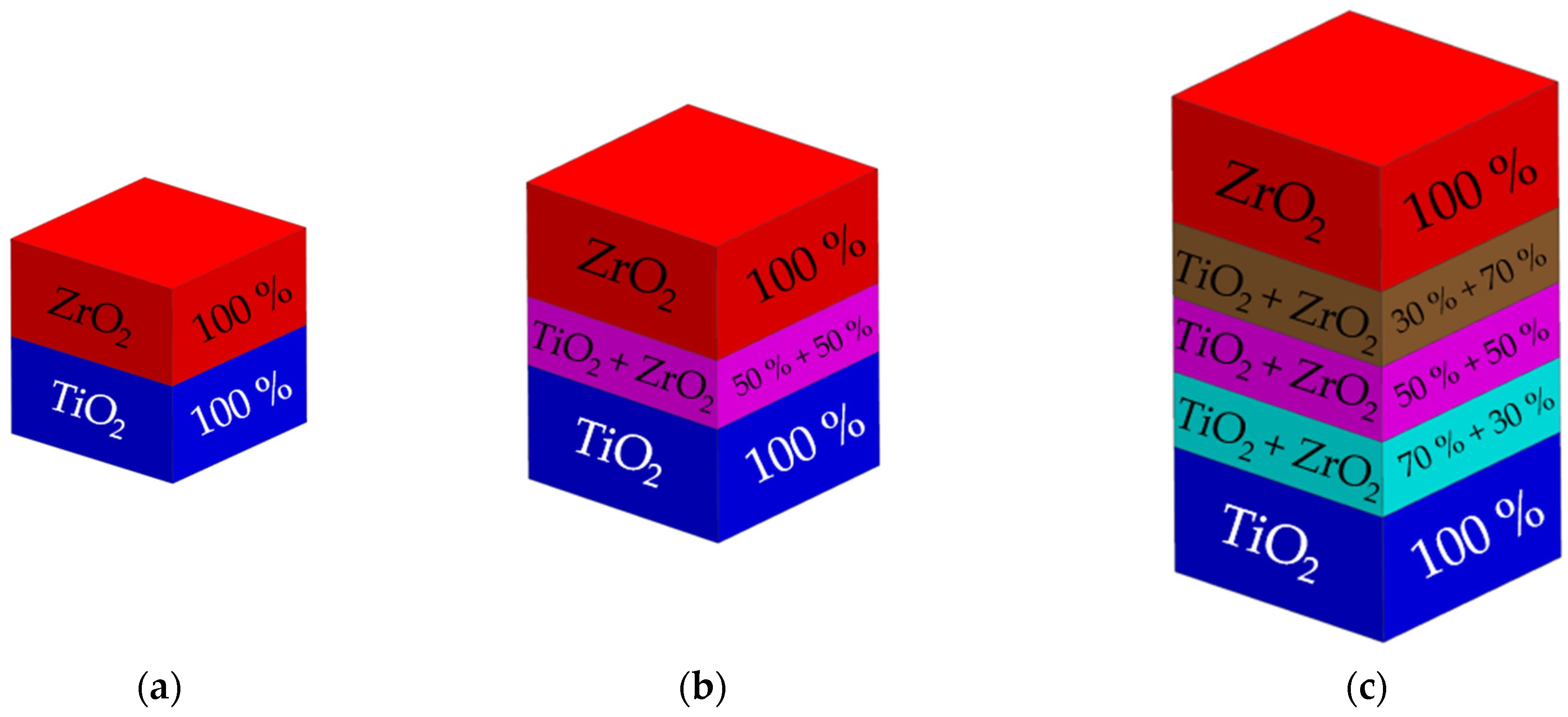
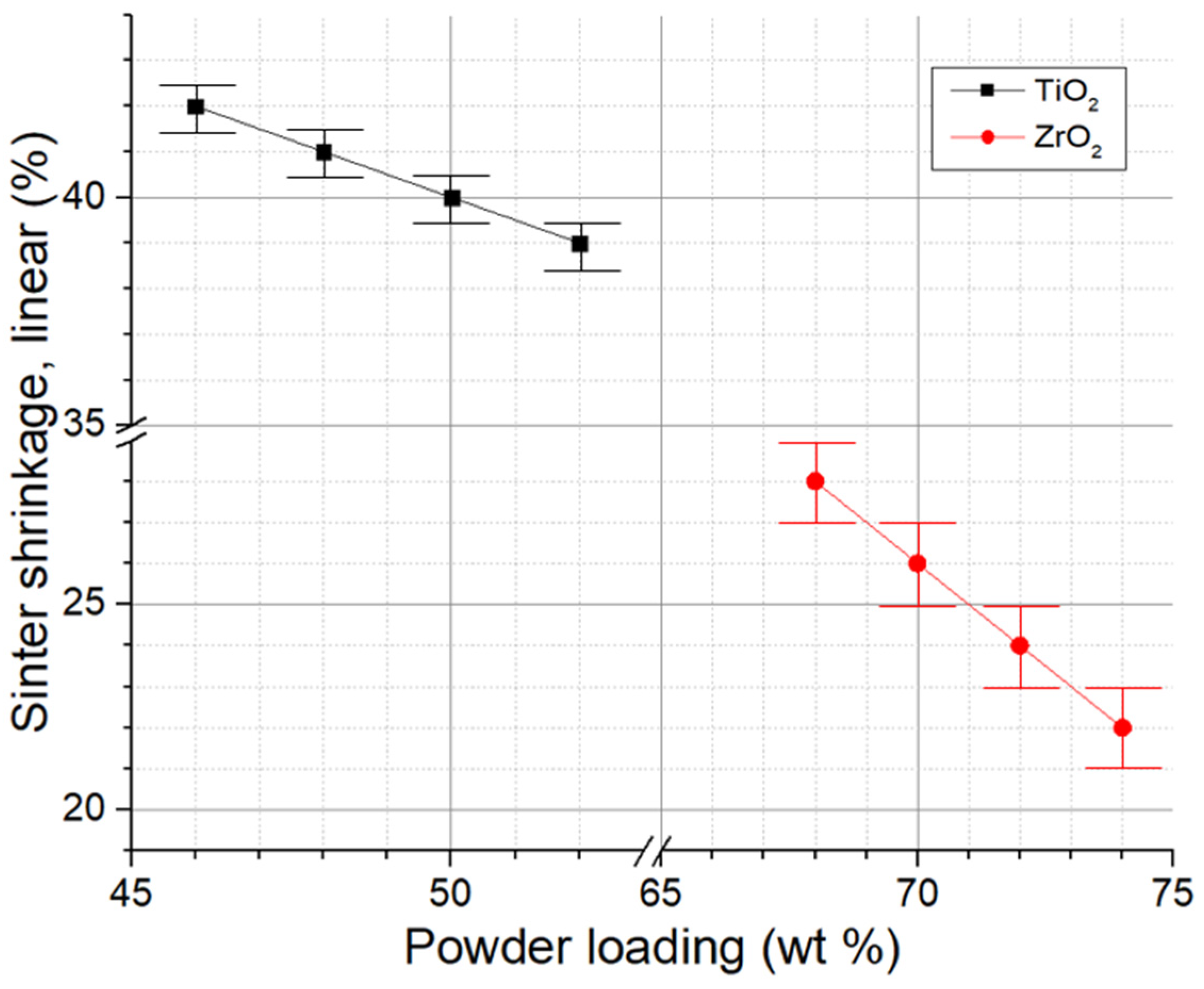
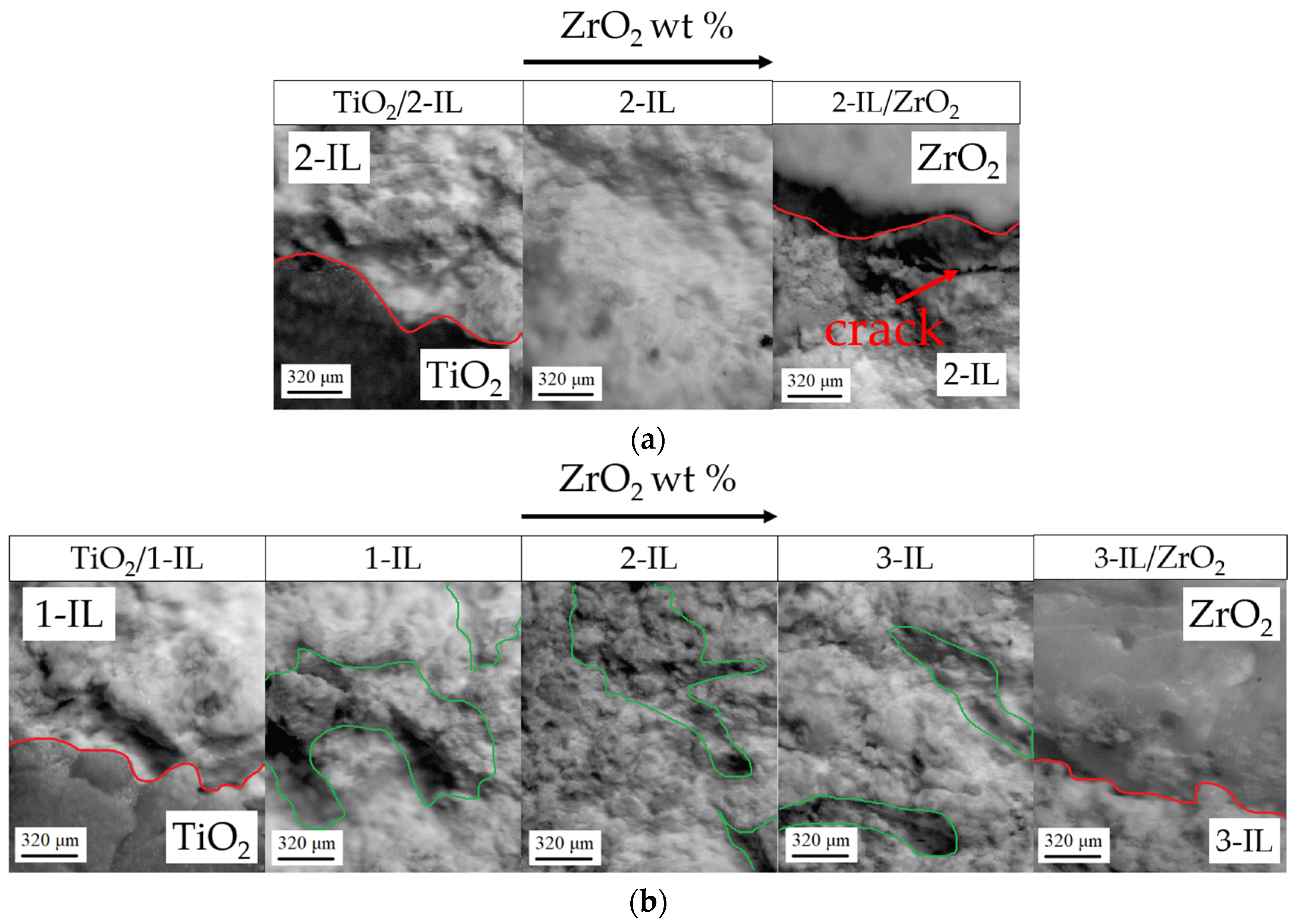
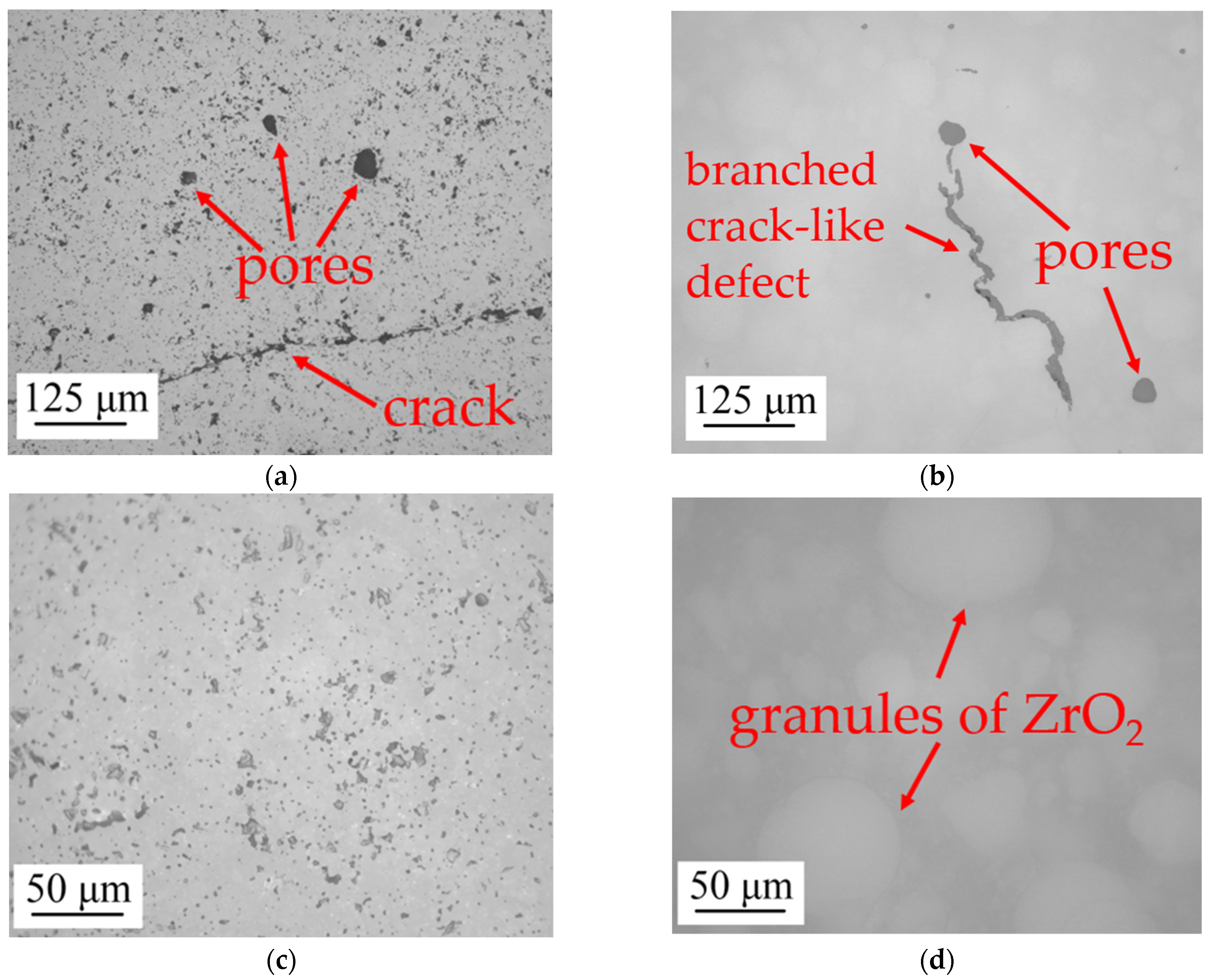
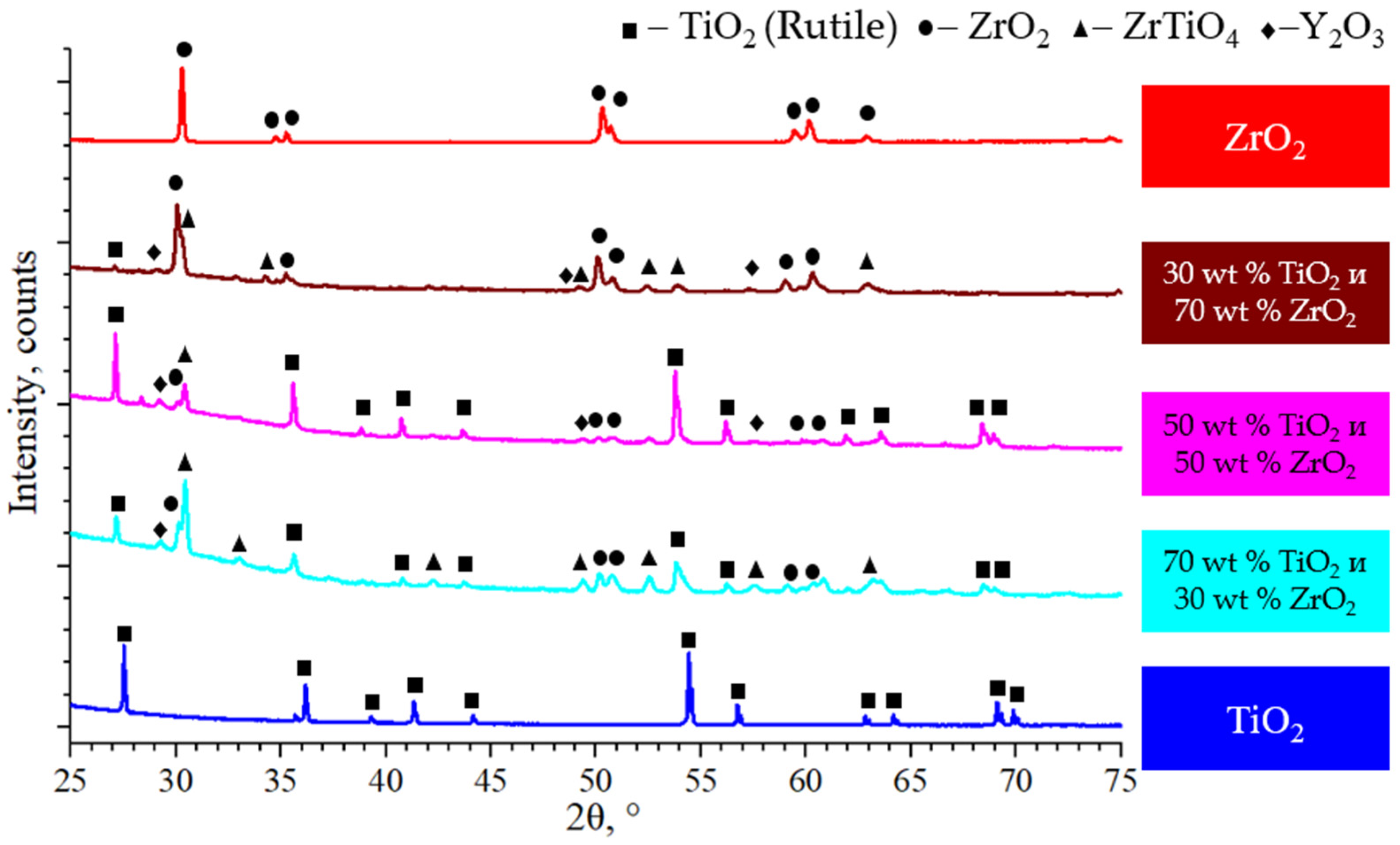

| Zone in the MCS3 | Microhardness, HV | Average Microhardness, HV |
|---|---|---|
| TiO2 | 640.7 | 636.7 |
| 635.5 | ||
| 630.8 | ||
| 637.4 | ||
| 639.1 | ||
| ZrO2 | 1120 | 1101.6 |
| 1111 | ||
| 1080 | ||
| 1100 | ||
| 1097 |
| Zone in Multi-Ceramic Sample | Elements | Average Content, wt.% |
|---|---|---|
| TiO2 | Ti | 59.95 |
| O | 40.05 | |
| ZrO2 | Zr | 69.96 |
| O | 25.71 | |
| Y | 4.33 |
| Interlayer | Zone form Figure 8 | Elements | Content, wt.% |
|---|---|---|---|
| 1-IL | a-Spec 1 | Ti | 18.24 |
| Zr | 51.54 | ||
| O | 30.25 | ||
| b-Spec 2 | Zr | 73.58 | |
| O | 26.42 | ||
| 2-IL | c-Spec 1 | Ti | 16.89 |
| Zr | 53.18 | ||
| O | 29.93 | ||
| d-Spec 2 | Zr | 74.03 | |
| O | 25.97 | ||
| 3-IL | e-Spec 1 | Ti | 6.64 |
| Zr | 65.83 | ||
| O | 27.53 | ||
| f-Spec 2 | Zr | 73.31 | |
| O | 26.69 |
Disclaimer/Publisher’s Note: The statements, opinions and data contained in all publications are solely those of the individual author(s) and contributor(s) and not of MDPI and/or the editor(s). MDPI and/or the editor(s) disclaim responsibility for any injury to people or property resulting from any ideas, methods, instructions or products referred to in the content. |
© 2023 by the authors. Licensee MDPI, Basel, Switzerland. This article is an open access article distributed under the terms and conditions of the Creative Commons Attribution (CC BY) license (https://creativecommons.org/licenses/by/4.0/).
Share and Cite
Repnin, A.; Sotov, A.; Popovich, A.; Masaylo, D. Development of TiO2/ZrO2 Multi-Material Obtained from Ceramic Pastes for Material Extrusion. Micromachines 2023, 14, 2177. https://doi.org/10.3390/mi14122177
Repnin A, Sotov A, Popovich A, Masaylo D. Development of TiO2/ZrO2 Multi-Material Obtained from Ceramic Pastes for Material Extrusion. Micromachines. 2023; 14(12):2177. https://doi.org/10.3390/mi14122177
Chicago/Turabian StyleRepnin, Arseniy, Anton Sotov, Anatoliy Popovich, and Dmitriy Masaylo. 2023. "Development of TiO2/ZrO2 Multi-Material Obtained from Ceramic Pastes for Material Extrusion" Micromachines 14, no. 12: 2177. https://doi.org/10.3390/mi14122177
APA StyleRepnin, A., Sotov, A., Popovich, A., & Masaylo, D. (2023). Development of TiO2/ZrO2 Multi-Material Obtained from Ceramic Pastes for Material Extrusion. Micromachines, 14(12), 2177. https://doi.org/10.3390/mi14122177







